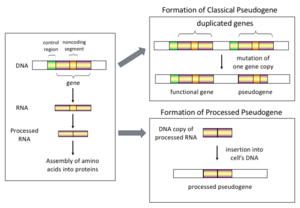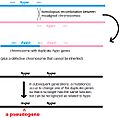Pseudogene facts for kids
Pseudogenes are special genes that have lost their original job. Think of them like old tools that don't work anymore. They can't make proteins, which are the building blocks and workers of our bodies. Or, they might not even be "turned on" in the cell to do anything. Scientists first started using the word "pseudogene" in 1977.
These "broken" genes can happen because of tiny changes called mutations. Sometimes, a gene's job just isn't needed anymore for an organism to survive. Even though pseudogenes don't make proteins, their DNA can still be important. They might act like other non-coding DNA that helps control how other genes work.
Contents
What Are Pseudogenes?
Most pseudogenes look a lot like real genes. However, they have small mistakes that stop them from working. These mistakes can prevent them from making proteins or even from making RNA, which is like a messenger molecule for genes. For example, some pseudogenes are copies of rRNA genes that no longer work.
For a long time, scientists thought pseudogenes were just "junk DNA". This meant they believed these genes had no purpose and were just leftover bits of genetic material. However, we now know that many pseudogenes are not junk at all! They can hold amazing clues about how living things have changed over time.
Pseudogenes and Evolution
Pseudogenes are like a secret diary of evolution. They share a common history with working genes. Imagine two different types of animals, like a dog and a wolf. They both came from a common ancestor millions of years ago. In the same way, a pseudogene and its working "parent" gene also came from a common ancestor. Over millions of years, they slowly changed and became different.
By studying pseudogenes, scientists can learn about the history of genes. They can see how genes have changed, duplicated, or stopped working over long periods. This helps us understand how different species developed and how our own bodies work.
How Do Pseudogenes Form?
Pseudogenes can form in a few ways. One common way is when a working gene gets copied, but the copy isn't perfect. This new copy might have mistakes that stop it from working. Over time, more mutations can build up in this non-working copy, making it even more different from the original gene.
Another way pseudogenes can form is when a gene that once worked perfectly gets damaged. This damage can be a mutation that makes the gene unable to produce its protein or turn on. If the organism can still survive without that specific gene working, it might just become a pseudogene.
Why Are Pseudogenes Important?
Even though pseudogenes don't make proteins, they are very useful for scientists.
- Evolutionary Clues: They help us trace the history of genes and how species have evolved. They show us how genes have changed over millions of years.
- Gene Regulation: Some pseudogenes can actually influence how other working genes behave. They might act like switches, turning other genes on or off.
- Disease Research: Studying pseudogenes can sometimes help us understand human diseases. Changes in pseudogenes might be linked to certain health conditions.
- Genetic Diversity: They add to the variety in our DNA. This diversity is important for how species adapt and survive.
So, pseudogenes are not just "junk." They are fascinating parts of our genome that tell us a lot about life's history and how our bodies work.
Images for kids
See also
 In Spanish: Pseudogén para niños
In Spanish: Pseudogén para niños






